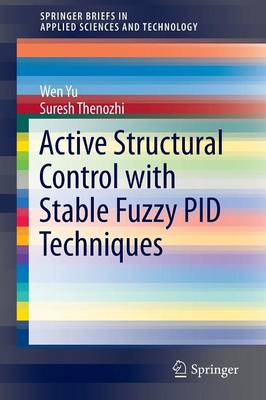SpringerBriefs in Applied Sciences and Technology
2 total works
Active Structural Control with Stable Fuzzy PID Techniques
by Wen Yu and Suresh Thenozhi
This book presents a detailed discussion of intelligent techniques to measure the displacement of buildings when they are subjected to vibration. It shows how these techniques are used to control active devices that can reduce vibration 60-80% more effectively than widely used passive anti-seismic systems.
After introducing various structural control devices and building-modeling and active structural control methods, the authors propose offset cancellation and high-pass filtering techniques to solve some common problems of building-displacement measurement using accelerometers. The most popular control algorithms in industrial settings, PD/PID controllers, are then analyzed and then combined with fuzzy compensation. The stability of this combination is proven with standard weight-training algorithms. These conditions provide explicit methods for selecting PD/PID controllers. Finally, fuzzy-logic and sliding-mode control are applied to the control of wind-induced vibration. The methods described are supported by reports of experimental studies on a two-story building prototype.This book is a valuable resource for academic researchers interested in the effects of control and mechatronic devices within buildings, or those studying the principles of vibration reduction. Practicing engineers working on the design and construction of any sort of high-rise or vulnerable building and concerned with the effects of either wind or seismic disturbances benefit from the efficacy of the methods proposed.
Active Control of Bidirectional Structural Vibration
by Wen Yu and Satyam Paul
This book focuses on safeguarding civil structures and residents from natural hazards such as earthquakes through the use of active control. It proposes novel proportional-derivative (PD) and proportional-integral-derivative (PID) controllers, as well as discrete-time sliding mode controllers (DSMCs) for the vibration control of structures involving nonlinearities. Fuzzy logic techniques are used to compensate for nonlinearities.
The first part of the book addresses modelling and feedback control in inelastic structures and presents a design for PD/PID controllers. In the second part, classical PD/PID and type-2 fuzzy control techniques are combined to compensate for uncertainties in the structures of buildings. The methodology for tuning the gains of PD/PID is obtained using Lyapunov stability theory, and the system's stability is verified. Lastly, the book puts forward a DSMC design that does not require system parameters, allowing it to be more flexibly applied. All program codes used in the paper are presented in a MATLAB (R)/Simulink (R) environment.Given its scope, the book will be of interest to mechanical and civil engineers, and to advanced undergraduate and graduate engineering students in the areas of structural engineering, structural vibration, and advanced control.

